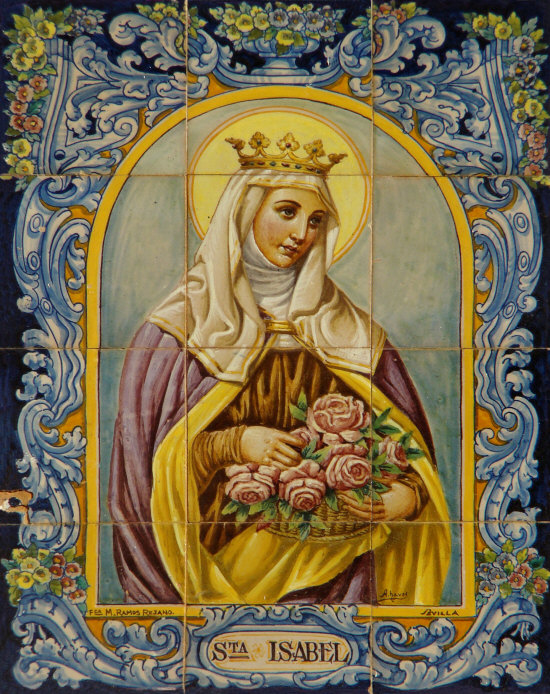
Aunque las Cortes de Aragón la declararon patrona del reino en 1678, es Zaragoza la que acumula más recuerdos y referencias a esta santa, nacida en el palacio de la Aljafería hacia 1270. A diferencia de otros santos aragoneses, no tiene dedicada una capilla en El Pilar o la Seo, pero la monumental iglesia barroca de la plaza del Justicia está bajo su advocación. También lleva su nombre una de las calles que saliendo de dicha plaza desemboca en una de las arterias más transitadas de Zaragoza: la calle Alfonso.
The iconography of that Infanta of Aragon and Queen of Portugal focuses mainly on her heroic charity, directed mainly to the poor and the sick. The image of St. Charles represents her with royal crown and purple mantle, a mantle that she holds with both hands and is full of roses.
El rostro, de una tonalidad entre blanquecina y sonrosada, es una muestra de la expresividad barroca, una combinación armoniosa entre lo sublime y lo sencillo. “Delicadeza” es el término que mejor podría definir la imagen. Su contemplación llevará a algunos a disquisiciones sobre dónde empieza la historia y termina la leyenda, pues el repertorio hagiográfico es pródigo en ejemplos de reinas y princesas caritativas que, interrogadas por sus padres o maridos sobre el contenido de los pliegues de sus mantos, enseñan rosas en vez de las monedas o los alimentos destinados a los pobres.
To this it should be objected that no legend can cast doubt on the testimonies about Elizabeth's charity, an expression of her faith in identifying the patients with Christ. She was a saint who, like others, was a real mother of mercy.
Unos cincuenta años antes de Cristo, el libro de la Sabiduría (1, 8) mostraba el retrato de una época en la que la felicidad pasaba por coronarse de rosas antes de que quedaran marchitas. Pero las rosas siempre tienen espinas y también, por supuesto, la propia vida.
Those thorns were not spared to the sweet, kind and intelligent Queen Elizabeth. Her unfurled mantle of roses is an image of her own life. Note, however, that the mantle shows the roses, not the thorns.
And it is that the Christian does not hide the reality of life but gives it a new attunement: the supernatural one, for the authentic Christian life is that of identification with Christ.
Devotion to the saints is illuminated by the consideration that they are other Christs. Without saints, the Christianity becomes more inaccessible. Remove the saints and the prophets, and we are left only with the spectator and immobile God of the philosophers.

St. Elizabeth of Portugal, pray for peace in our countries. She is patroness of the territories at war.
An Aragonese saint of the twentieth century, St. Josemaría Escrivá, once referred to the holy queen in these terms: "That kindly sanctity of an infanta of Aragon, Queen Isabella of Portugal, whose passage through the world was like a luminous sowing of peace among men and peoples.
No cabe un prodigio mayor de síntesis en estas elogiosas palabras. Frente a una “santidad” rigorista y antipática, tenemos aquí un ejemplo de naturalidad, una demostración de que la santidad también puede habitar en los palacios y moverse con soltura en banquetes, audiencias y visitas. En la feria de las intrigas y las mezquindades, la santidad resulta posible si se mueve al compás de la presencia de Dios. Esa presencia se alimentaba en la piedad de Isabel, en el rezo de los salmos y en la misa diaria. De ahí salía la fortaleza de alguien que, a semejanza de la Esther bíblica, bien habría podido decir: “Mi Señor y Dios, no tengo otro defensor que Tú” (Est 4, 17).
Her husband, King Don Dionis, often seemed to be more interested in the gallantries of the troubadours than in the affairs of government. His continuous infidelities were public knowledge, but Isabella kept quiet and usually changed her conversation or withdrew to the palace chapel when the unleashed tongues of the courtiers sought to torment her with the latest news of her husband's "gallant life".
of his son Alfonso towards his father, because he was showing signs of preference towards his bastard brothers. The queen would go to a plain, near Lisbon, to avoid the clash between the armies of her husband and her son, and although she managed to avoid it, she would be imprisoned by royal order behind the walls of the fortress of Alenquer, because of the unjust suspicion that she herself had fomented Alfonso's rebellion. She would leave, however, to assist Don Dionís on his deathbed in 1325.
Será entonces cuando el propio rey recordó a Alfonso que la reina era dos veces su madre, pues le dio la vida entre lágrimas y oraciones. Isabel iría al encuentro de Dios en 1336 en Estremoz, en medio del calor y las fatigas del ardiente verano del Alentejo, cuando se dirigía a interponerse entre los ejércitos enfrentados de dos Alfonsos: su hijo, Alfonso IV de Portugal, y su nieto, Alfonso XI de Castilla.
Fue también la pacificadora, pues las bienaventuranzas nos muestran el retrato de los imitadores de Cristo, y llaman hijos de Dios a los que trabajan por la paz (Mt 5,9).
Only those who are filled with God have peace and are in a position to transmit it. Peace often comes also from that kindly holiness, even if it is often misunderstood, which sees in others other children of God.
Antonio R. Rubio Plo
Degree in History and Law
International writer and analyst
@blogculturayfe / @arubioplo
